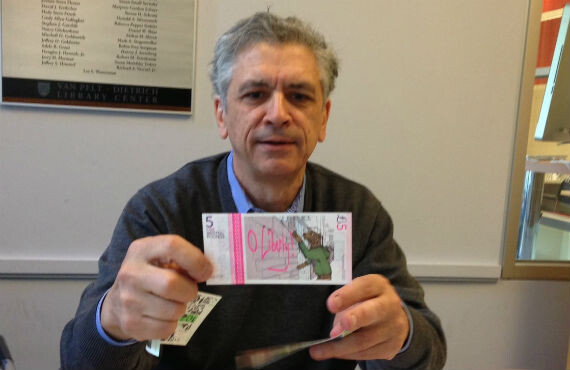Penn Students Travel the World to Research Alternative Currencies
There are about 4,000 alternative currencies in use around the world, and they vary widely. In Zimbabwe, a country with so much hyperinflation that it hasn’t had a national currency since 2009, people create colorful non-bank notes and barter for goods and services. During World War II, the United States government issued ration coupons to ensure that all Americans got their fair share of scarce necessities.
For the past six years, Andrew Lamas, a professor in the Urban Studies Program of the School of Arts and Sciences and a lecturer in the School of Social Policy and Practice at the University of Pennsylvania, has been studying these and other alternative currencies and their global use.
Alternative currencies typically are separate from the dominant national currencies of the countries where they exist and are usually neither traditional or nationally sanctioned.
However, Lamas notes that, “Just a few years ago, all European countries who had currencies for their nations moved to the euro. Within about 18 months of establishing the euro, local alternative currencies emerged all over Europe.”
With support from the Provost’s Undergraduate Research Mentoring Program (PURM), Lamas and his students have conducted research in cities in the United States, England, Italy, Spain, Argentina, Ecuador, Senegal, Morocco, Japan and South Korea.
Julia Luscombe, who graduated from Penn in 2010, used a PURM grant to travel to communities in the United States, South Korea and Japan to research local currencies and gain an understanding of why they exist. Luscombe documented the experience in a film that looked at the motivations behind community currencies around the world.
“The project was eye-opening. It introduced me to entirely new ways of thinking about economics and development, and it allowed me to experience the currency systems first-hand and interview participants,” says Luscombe, a graduate of the College and Wharton’s Huntsman Program in International Studies & Business.
After Commencement, Luscombe received a Fulbright grant that took her to Ecuador. There, she worked with a non-profit organization, the Fundación Pachamama, to set up alternative currencies in three rural communities as part of a local economic development strategy."
Another student who worked on alternative currency research came to the topic as a way to pursue her interests in Islam and economics. International relations major Aya Saed, who graduated in May, spent time in Spain and Morocco during the summer between her freshman and sophomore years, studying efforts to develop an Islamic currency in those countries.
She conducted research on the dinar, a currency currently used across Malaysia and Indonesia, and in certain communities in South Africa.
Closer to home, an unusual example of alternative currency is the Penn TimeBank. The project was co-founded by 2013 graduate Julia Graber another of Lamas’ mentees.
“A timebank is considered to be an alternative currency because it mediates exchanges in denominations of time instead of dollars,” Graber explains.
In the student-led Penn TimeBank, members trade time for services in an hour-for-hour exchange. For instance, one member’s hour of English lessons could be exchanged for an hour of babysitting.
The Penn TimeBank was established through a Creative Ventures Fund grant from Kelly Writers House. It has more than 150 members and 16 student coordinators, Graber says, and is now part of the newly formed Mid-Atlantic Regional Time Banks Association, a local network of alternative currency groups.








